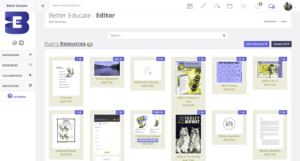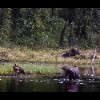
Cow and moose calves feed in the shallows
Moose
The moose (North America) or elk (Eurasia) (Alces alces), is a member of the New World deer subfamily and is the largest and heaviest extant species in the Deer family. Moose are distinguished by the broad, palmate (open-hand shaped) antlers of the males; other members of the deer family have antlers with a dendritic (“twig-like”) configuration. Moose typically inhabit boreal forests and temperate broadleaf and mixed forests of the Northern Hemisphere in temperate to subarctic climates.
The most common moose predators are the gray wolf along with bears and humans. Hunting and other human activities have caused a reduction in the size of the moose’s range over time.
Moose have been reintroduced to some of their former habitats. Currently, most moose are found in Canada, Alaska, New England (with Maine having the most of the lower 48 states), Fennoscandia, Baltic states, and Russia. Their diet consists of both terrestrial and aquatic vegetation.
Unlike most other deer species, moose are solitary animals and do not form herds. Although generally slow-moving and sedentary, moose can become aggressive and move quickly if angered or startled. Their mating season in the autumn features energetic fights between males competing for a female.
Appearance
Hooves
As with all members of the order Artiodactyla (even-toed ungulates), moose feet have two large keratinized hooves corresponding to the third and fourth toe, with two small posterolateral dewclaws (vestigial digits), corresponding to the second and fifth toe. The hoof of the fourth digit is broader than that of the third digit, while the inner hoof of the third digit is longer than that of the fourth digit. This foot configuration may favour striding on soft ground.[85] The moose hoof splays under load, increasing surface area, which limits sinking of the moose’s foot into soft ground or snow, and which increases efficiency when swimming.
The body weight per footprint surface area of the moose foot is intermediate between that of the pronghorn foot, (which have stiff feet lacking dewclaws—optimized for high-speed running) and the caribou foot (which are more rounded with large dewclaws, optimized for walking in deep snow). The moose’s body weight per surface area of footprint is about twice that of the caribou.
Antlers
Bull moose have antlers like other members of the deer family. Cows select mates based on antler size. Bull moose use dominant displays of antlers to discourage competition and will spar or fight rivals. The size and growth rate of antlers is determined by diet and age; symmetry reflects health.
The male’s antlers grow as cylindrical beams projecting on each side of the head at right angles to the midline of the skull, and then fork. The lower prong of this fork may be either simple, or divided into two or three tines, with some flattening. Moose antlers are broad and palmate (flat) with tines (points) along the outer edge. The antlers of mature Alaskan adult bull moose (5 to 12 years old) have a normal maximum spread greater than 200 centimeters (79 in).
By the age of 13, moose antlers decline in size and symmetry. The widest spread recorded was 210 centimeters (83 in) across. (An Alaskan moose also holds the record for the heaviest weight at 36 kilograms (79 lb)).
Population
North America
In Canada there are an estimated 500,000 to 1,000,000 moose, with 150,000 in Newfoundland in 2007 descended from just four that were introduced in the 1900s. In United States there are estimated to be around 300,000, as follows:
- Alaska’s state Department of Fish and Game estimated 200,000 in 2011
- in the Northeast a wildlife ecologist estimated 50,000 in New York and New England in 2007, with expansion expected
- in the Rocky Mountain states Wyoming is said to have the largest share in its 6-state region, and its Fish and Game Commission estimated 7,692 in 2009
- in the Upper Midwest Michigan estimated 433 (in its Upper Peninsula) in 2011
- Wisconsin Department of Natural Resources 20–40 (close to its upper-peninsula border with Michigan) in 2003
- Minnesota 5600 in its northeast in 2010, and under 100 in its northwest in 2009
Europe/Asia
Recorded numbers are sporadic according to regional reporting data.
- Russia had a population of approximately 600,000 moose in 2007
- Finland reported a summer population of 115,000 moose in 2009
- In Norway there were a winter population of around 120,000 moose in 2009
- Latvia had 21,000 moose in 2015
- Estonia recorded a population of 13,260
- Poland had 2,800 moose
- The Czech Republic recorded 50 animals
- In Sweden the summer population is estimated to be 300,000–400,000 moose
Human Interactions and Behaviour
Moose are not usually aggressive towards humans but can be provoked or frightened to behave with aggression. In terms of raw numbers, they attack more people than bears and wolves combined, but usually with only minor consequences. In the Americas, moose injure more people than any other wild mammal, and worldwide, only hippopotamuses injure more. When harassed or startled by people or in the presence of a dog, moose may charge. Also, as with bears or any wild animal, moose that have become used to being fed by people may act aggressively when denied food.
During the fall mating season, bull moose may be aggressive toward humans because of the high hormone levels they experience. Cows with young calves are very protective and will attack humans who come too close, especially if they come between mother and calf. Unlike other dangerous animals, moose are not territorial, and do not view humans as food, and will therefore usually not pursue humans if they simply run away.
Diet
The moose is an herbivore and is capable of consuming many types of plant or fruit. The average adult moose needs to consume 9,770 kcal (40.9 MJ) per day to maintain its body weight. Much of a moose’s energy is derived from terrestrial vegetation, mainly consisting of forbs and other non-grasses, and fresh shoots from trees such as willow and birch. These plants are rather low in sodium, and moose generally need to consume a good quantity of aquatic plants. While much lower in energy, aquatic plants provide the moose with its sodium requirements, and as much as half of their diet usually consists of aquatic plant life. In winter, moose are often drawn to roadways, to lick salt that is used as a snow and ice melter. A typical moose, weighing 360 kg (794 lb), can eat up to 32 kg (71 lb) of food per day.
Habitat
Moose require habitat with adequate edible plants (e.g., pond grasses, young trees and shrubs), cover from predators, and protection from extremely hot or cold weather. Moose travel among different habitats with the seasons to address these requirements. Moose are cold-adapted mammals with thickened skin, dense, heat-retaining coat, and a low surface:volume ratio, which provides excellent cold tolerance but poor heat tolerance. Moose survive hot weather by accessing shade or cooling wind, or by immersion in cool water. In hot weather, moose are often found wading or swimming in lakes or ponds. When heat-stressed, moose may fail to adequately forage in summer and may not gain adequate body fat to survive the winter. Also, moose cows may not calve without adequate summer weight gain.
Moose avoid areas with little or no snow as this increases the risk of predation by wolves and avoid areas with deep snow, as this impairs mobility. Thus, moose select habitat on the basis of trade-offs between risk of predation, food availability, and snow depth.
With reintroduction of bison into boreal forest, there was some concern that bison would compete with moose for winter habitat, and thereby worsen the population decline of moose. However, this does not appear to be a problem. Moose prefer sub-alpine shrublands in early winter, while bison prefer wet sedge valley meadowlands in early-winter. In late-winter, moose prefer river valleys with deciduous forest cover or alpine terrain above the tree line, while bison preferred wet sedge meadowlands or sunny southern grassy slopes.
Known Predators
A full-grown moose has few enemies except Siberian tigers (Panthera tigris altaica) which regularly prey on adult moose, but a pack of gray wolves (Canis lupus) can still pose a threat, especially to females with calves. Brown bears (Ursus arctos) are also known to prey on moose of various sizes, including many pregnant adult cows in some parts of Alaska and Scandinavia and even the rare bull moose, and are the only predator besides the wolf to attack moose both in Eurasia and North America.
However, brown bears are more likely to take over a wolf kill or to take young moose than to hunt adult moose on their own. American black bears (Ursus americanus) and cougars (Puma concolor) can be significant predators of moose calves in May and June and can, in rare instances, prey on adults (mainly cows rather than the larger bulls). Wolverine (Gulo gulo) are most likely to eat moose as carrion but have killed moose, including adults, when the large ungulates are weakened by harsh winter conditions.
Orcas (Orcinus orca, also known as killer whales) are the moose’s only known marine predator as they have been known to prey on moose swimming between islands out of North America’s Northwest Coast, however, there is at least one recorded instance of a moose preyed upon by a Greenland shark.
[Please note that formatting does not translate to this blog, and so a PDF version is available here.]
*Edit- Tumbnail added 02/14/2021. Thumbnail created using http://makethumbnails.com/
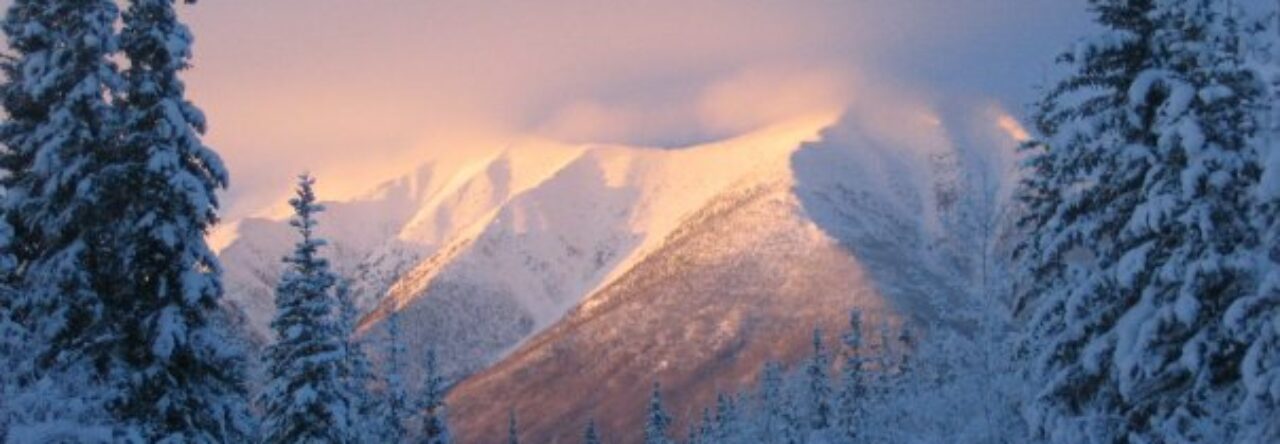
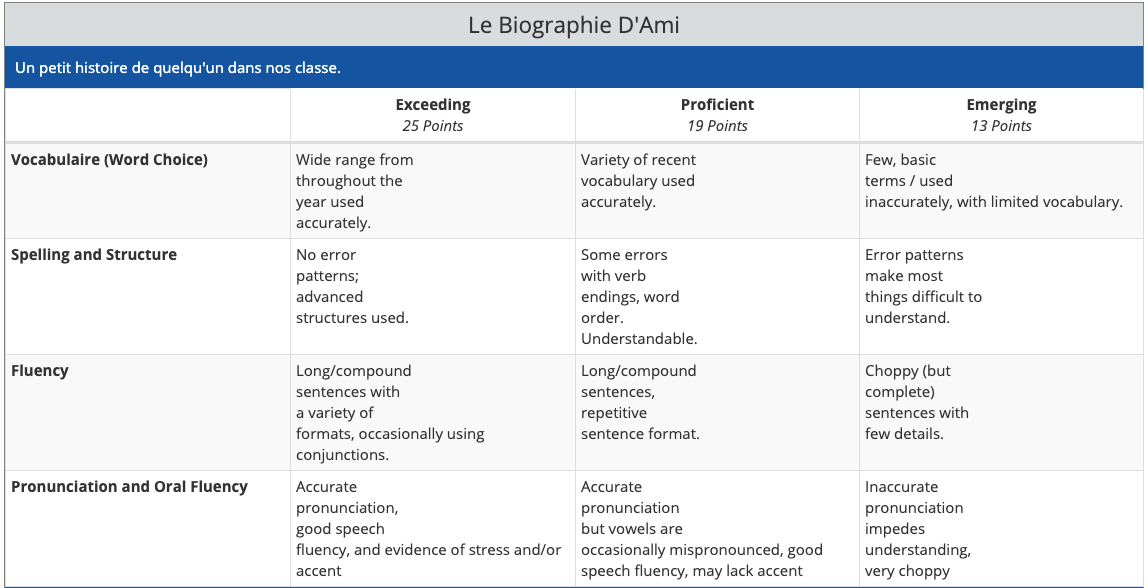
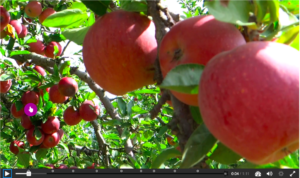
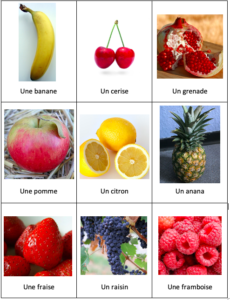

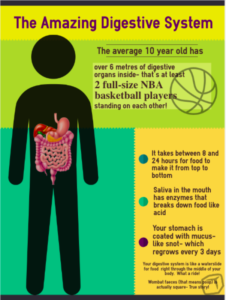
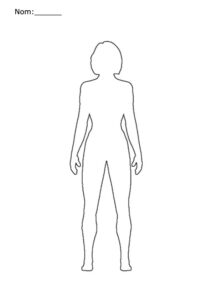
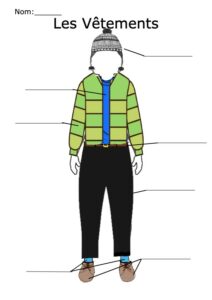
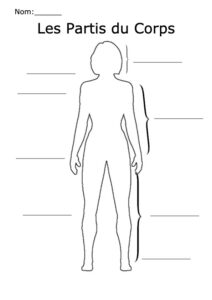

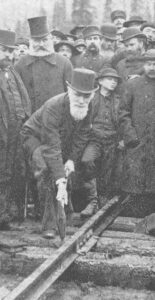 of reasons for this; first, it leads into a class activity of prediction and inference using the modified image; second, because there is so much information contained in the original, that the intended subject of the photo is partially subverted by the periphery. By reducing the extraneous elements, it allows the learner’s focus to be directed to the intended content. I also reduced the contrast of the background to soften the perception of the image so that increasing the brightness does not wash out detail for visually challenged users.
of reasons for this; first, it leads into a class activity of prediction and inference using the modified image; second, because there is so much information contained in the original, that the intended subject of the photo is partially subverted by the periphery. By reducing the extraneous elements, it allows the learner’s focus to be directed to the intended content. I also reduced the contrast of the background to soften the perception of the image so that increasing the brightness does not wash out detail for visually challenged users.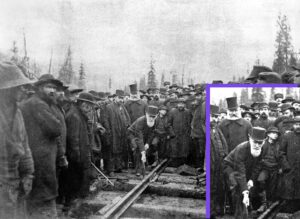


 A big step towards accessibility for bettereducate.com would be to improve the level of contrast between text and background on the homepage. Light grey text on white becomes practically illegible with even the slightest visual impairment, and is a colour palette that absorbs the red icons integrated into the content throughout the page.
A big step towards accessibility for bettereducate.com would be to improve the level of contrast between text and background on the homepage. Light grey text on white becomes practically illegible with even the slightest visual impairment, and is a colour palette that absorbs the red icons integrated into the content throughout the page.